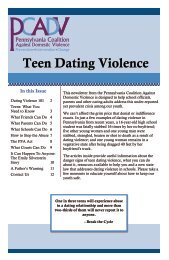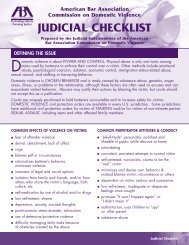Toolkit with Report Form - Pennsylvania Coalition Against Domestic ...
Toolkit with Report Form - Pennsylvania Coalition Against Domestic ...
Toolkit with Report Form - Pennsylvania Coalition Against Domestic ...
You also want an ePaper? Increase the reach of your titles
YUMPU automatically turns print PDFs into web optimized ePapers that Google loves.
Section five<br />
Physical Injury<br />
Severe or moderate injury to clients and staff<br />
is probably the most frequently encountered<br />
issue. Severe injury or multiple injuries<br />
can disrupt services and/or trigger crisis<br />
reactions in witnesses. When the cause of<br />
the injury is unknown or there are multiple<br />
people <strong>with</strong> injuries or the injuries sustained<br />
are of a severe nature, staff may be called<br />
upon to provide assistance. The sight of<br />
such injuries can be incredibly powerful<br />
for witnesses and can initiate an emotional<br />
and/or physical crisis reaction; providing<br />
assistance to these individuals can also<br />
distract staff from their usual responsibilities.<br />
When the nature or cause of the injury is<br />
unknown, this uncertainty may be enough<br />
to send someone into a crisis reaction.<br />
Programs can alleviate the impact of severe<br />
or moderate injuries by being well prepared<br />
<strong>with</strong> a clear response plan in place.<br />
Assisting Medical Personnel<br />
When faced <strong>with</strong> multiple injured people,<br />
it is a good idea to put a nametag on each<br />
injured person. This will assist hospital staff<br />
in accurately identifying the patient and<br />
will allow them to more quickly provide<br />
appropriate treatment.<br />
When calling for assistance, provide<br />
specific and detailed directions to<br />
the emergency dispatcher so that first<br />
responders can locate the correct location/<br />
entrance. Accurate communication can<br />
save crucial time, especially if your shelter<br />
is in an undisclosed or obscure location or<br />
has multiple entry points. Sending someone<br />
outside to greet the ambulance helps secure<br />
assistance more quickly.<br />
Transportation<br />
Transporting a sick or injured client, volunteer<br />
or staff member in a program or personal<br />
vehicle should occur:<br />
◗ Only in extreme circumstances<br />
◗ If an ambulance cannot reach<br />
the site<br />
Issues of liability must be considered.<br />
Transporting in a program or personal<br />
vehicle is not advised because it is<br />
impossible to know the extent of a person’s<br />
injuries or other health concerns, which<br />
could become an issue during transport.<br />
Follow your program’s existing procedure<br />
on providing emergency transportation to<br />
clients.<br />
If a resident, client, volunteer or staff person<br />
is transported by ambulance, it’s a good<br />
idea to have two staff accompany her/him<br />
to the hospital – one person to ride in the<br />
ambulance, a second to follow in another<br />
vehicle. (The second vehicle provides<br />
transportation back to the agency for both<br />
staff members).<br />
Staff should remain <strong>with</strong> the injured person<br />
until a family member or another responsible<br />
adult arrives. Do not leave an injured or<br />
seriously ill person alone at a medical facility.<br />
Wait until adequate support arrives.<br />
page 30<br />
When Crisis Strikes | <strong>Pennsylvania</strong> <strong>Coalition</strong> <strong>Against</strong> <strong>Domestic</strong> Violence | 2012








